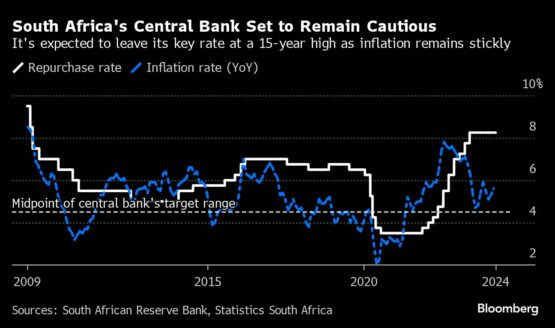South Africa’s central bank is set to keep interest rates unchanged for a fifth time in a row and signal a delayed start to an anticipated cutting cycle, with inflation risks still skewed to the upside.
Economists surveyed by Bloomberg expect Governor Lesetja Kganyago’s five-panel monetary policy committee to show its resolve in fighting price pressures by leaving the benchmark rate at a 15-year-high of 8.25%. Traders concur. Forward-rate agreements are pricing in no chance of a rate cut until November.
ADVERTISEMENT
CONTINUE READING BELOW
Read/listen: Roelof Botha deplores ‘ridiculously high interest rates’
The decision, expected shortly after 3 pm Wednesday Johannesburg time, is likely to be unanimous, according to economists polled in a separate survey.
South Africa’s annual inflation rate climbed to a four-month high of 5.6% last month, moving further above the midpoint of the central bank’s 3% to 6% target band where it prefers to anchor expectations.
Read: South Africa inflation expectations dip before rate meeting
Kganyago has repeatedly said that until inflation retreats to 4.5% in a sustainable manner and settles there, the central bank will be unwilling to adjust its policy stance. He is likely to do so again, said Koketso Mano, FirstRand’s First National Bank senior economist.

“We think they’ll continue to take a cautious approach to the start of the cutting cycle,” Mano said. “Simply because of inflation risks that are still tilted to the upside; especially if you follow some of the latest agricultural issues around hostile weather conditions at the start of this year that could have affected crops and the yields on crops.”
Food prices
The Agricultural Business Chamber of South Africa warned earlier this month that dryer and hotter-than-usual weather across the country’s main summer crop growing regions was hurting the outlook for the country’s key corn harvest, with risks to food prices.
Analysts say the central bank is also likely to adopt a guarded approach to making policy changes ahead of South African elections on May 29. Polls show the ruling African National Congress is at risk of losing its majority for the first time in three decades.
ADVERTISEMENT
CONTINUE READING BELOW
Read: What’s in store for interest rates in 2024?
In addition, Kganyago and his colleagues may prefer to wait until expected rate cuts are underway in the US and Europe before loosening policy here because of the potential spillovers to the rand, which influences import prices.
Another factor influencing the MPC’s decision may be its wariness over South Africa’s fiscal outlook adding to “unnecessary upside inflationary pressure,” said Sanisha Packirisamy, an economist at Momentum Investments, who expects a hold on Wednesday and only shallow cuts once the easing cycle starts.
Read: Sarb keeps repo rate steady at 8.25%
“They then have to apply a bit of caution, and I think it limits their ability to cut as much as what inflation dynamics would ordinarily allow them, because they’re worried about those inflation risks,” Packirisamy said.
© 2024 Bloomberg


